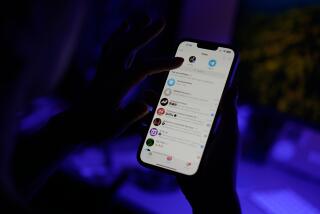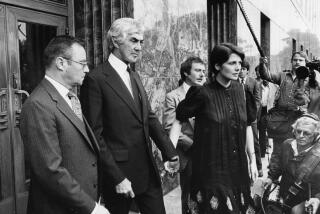Defense Questions Motives of Bombing Trial Witness
DENVER â One day she was the governmentâs star witness, escorted to the stand to help prosecutors convict and put to death those responsible for the bombing of the Oklahoma City federal building.
The next day she was a drug user, a careless mother, a gun runner, an anti-government militant and a rifle-toting desert woman not above perjuring herself to stay out of prison.
Wednesday it was the defenseâs turn to question Lori Fortier.
Stephen Jones, the attorney for defendant Timothy J. McVeigh, repeatedly challenged Fortierâs credibility and her motives for turning against her one-time friend and--if she is to be believed--for allowing 168 people, including 19 children, to die when she knew all along that the bomb was coming.
He told her: âAll you had to do to prevent the deaths of these 168 people was to pick up the phone, and you didnât do that.â
And in an impromptu press conference in front of the courthouse, Michael E. Tigar, the attorney for Terry L. Nichols, who will stand trial later in the bombing case, castigated Fortier for having the gall to portray herself as righteous.
âWelcome to the dope-smoking, methamphetamine-swilling world of [Fortierâs hometown of] Kingman, Arizona,â he said. âTerry Nichols had nothing to do with that world.
âEven by the admission of the governmentâs star witness, Terry Nichols wasnât involved in it.â
Fortier and her husband, Michael, had been close friends of McVeigh. They often opened their house to him for long periods of time. He was the best man at their wedding. When they went away on their honeymoon, he stayed at their home.
But, according to Fortierâs testimony for the government Tuesday, McVeigh changed dramatically after the 1993 FBI raid on a religious compound near Waco, Texas, in which about 80 people were killed. He became virulently anti-government in his politics and he warned that the time had come to âtake actionâ against the government.
Fortier described how McVeigh, a former Army buddy of her husbandâs, laid out his plans to rent a truck, stockpile ammonium nitrate and then blow up the Alfred P. Murrah Federal Building.
The Murrah building was destroyed on April 19, 1995--exactly two years after the FBI assault at Waco. Along with the 168 people killed, more than 500 were injured.
Under gentle questioning from chief prosecutor Joseph Hartzler, Fortier spoke with certainty Tuesday about McVeighâs drive to punish the government for the Waco raid. She said that he became very upset when her husband refused to help him and equally angry when Nichols at one point also âwanted outâ of the bomb plot.
Both defendants, if convicted, could face the death penalty. Michael Fortier, expected to testify later, has pleaded guilty to charges that he knew about the bomb plot before it was carried out, that he did not alert authorities and that he had trafficked in stolen firearms.
Under cross-examination from Jones on Wednesday, Lori Fortier was reserved, giving only âyesâ or ânoâ answers to almost all of his questions. At one point, she admitted that she had been heavily coached by prosecutors, spending hours with Hartzler--whom she referred to as âJoeâ--in âmock courtâ sessions to prepare for her testimony.
She also acknowledged heavy--sometimes weekly--drug use. She said that she and her husband traded and sold stolen weapons, some of which were given to her by McVeigh after they were taken in an Arkansas heist.
Jones read Fortier a series of statements made by the couple and captured by an FBI wiretap in their home after the bombing. She said that she did not remember most of the remarks, which had to do with the coupleâs plans to get rich from their knowledge of the alleged bombing conspiracy.
Fortier did remember talking to her parents and discussing that âthe movie and book rightsâ to the bombing story was âwhere the money is.â In other quotes, her husband mused about being paid for an appearance on television. âI found my career,â he said. âI can tell a fable. I can tell stories all day.â
âWe might get some bank out of this deal,â he said at another time, referring to his hope of making a million dollars. âI was thinking one cool one.â
Jones also portrayed the 24-year-old Fortier, mother of two children, as careless. She admitted that even though she and her husband were afraid of McVeigh, they often let him stay at their home, including when their first child was a baby.
And Jones asked the witness to read a press statement that she wrote, but never delivered, shortly after the bombing. Titled âJudge not, for yee [sic] shall be judged,â the statement attacked the media for reports on McVeighâs arrest and maintained his innocence.
It said in part: âIt really sickens me when I see my friendâs, yes my FRIENDâS, face on the cover of Time magazine as the face of terror.â
Her statement also insisted that an FBI composite drawing of one of the bomb suspects did not necessarily depict McVeigh.
Under questioning, Fortier said that she and her husband kept five guns at their home, including a new $600 rifle that she used, as well as blasting caps and other explosive materials and a bag of ammonium nitrate.
She also said that they shared many of McVeighâs anti-governmentâs leanings, read far-right propaganda and suspected the FBI of wrongdoing in the Waco raid. But she disagreed with McVeighâs version of what happened to the people at Waco.
âI donât believe they were murdered,â she said.
The trial continues today, with several McVeigh associates expected to testify about his anti-government views.
More to Read
Sign up for Essential California
The most important California stories and recommendations in your inbox every morning.
You may occasionally receive promotional content from the Los Angeles Times.











